Howard Walwyn presents a selection of fine clocks and barometers made during King George III’s reign, from 1760 to 1820, by illustrious makers of the time such as Ellicott and Vulliamy. Highlights include an ornately decorated table clock adorned with the royal coat of arms, a complex angle barometer – a hi-tech object of its age, and a pleasingly architectural in form longcase clock.
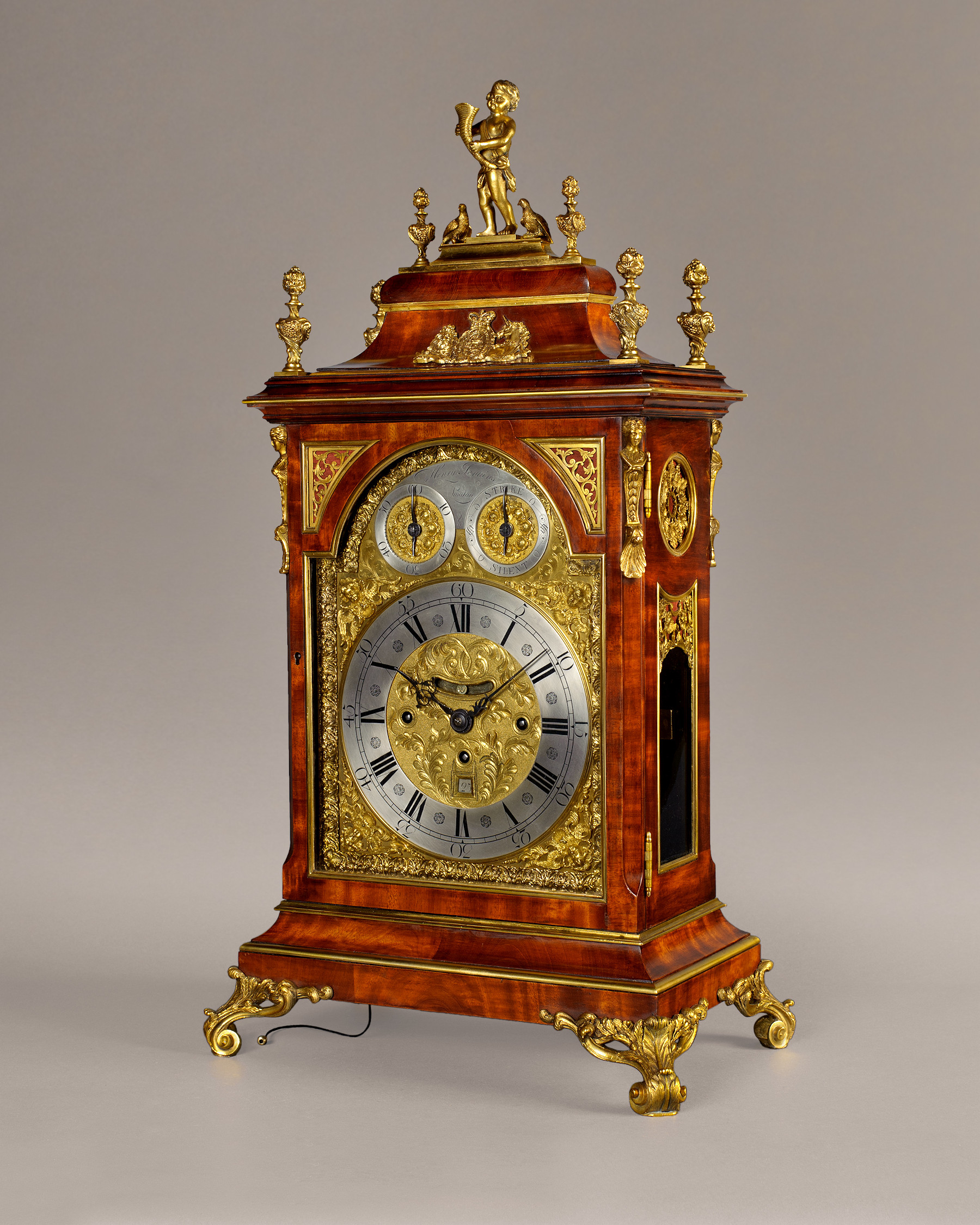
An important palace quality George III period mahogany table clock, the 8-day brass dial movement chiming the hours and quarters on 12 bells.
HENRY JENKINS, circa 1780
The exceptional mahogany case has a brass mount bearing the Royal Coat of Arms. The motto of the Order of the Garter is clearly visible and reads Honi soit qui mal y pense which translates as ‘shame on he who thinks ill of it’. Given its extraordinary quality and the ‘Royal’ mount, it is possible this clock was a Royal gift to a member of the Swedish aristocracy where the clock resided for many generations. Height: 76 cm Width: 41 cm
*Henry Jenkins is listed in ‘Watchmakers and Clockmakers of the World’ as working in Cheapside, London from 1730 to 1780. In 1760 Jenkins published a small booklet titled ‘A description of several geographical and astronomical clocks’. Astronomical clocks were a subject Jenkins was entitled to pronounce upon; a superb example by him can be found in the British Museum’s collection of fine period English clocks.
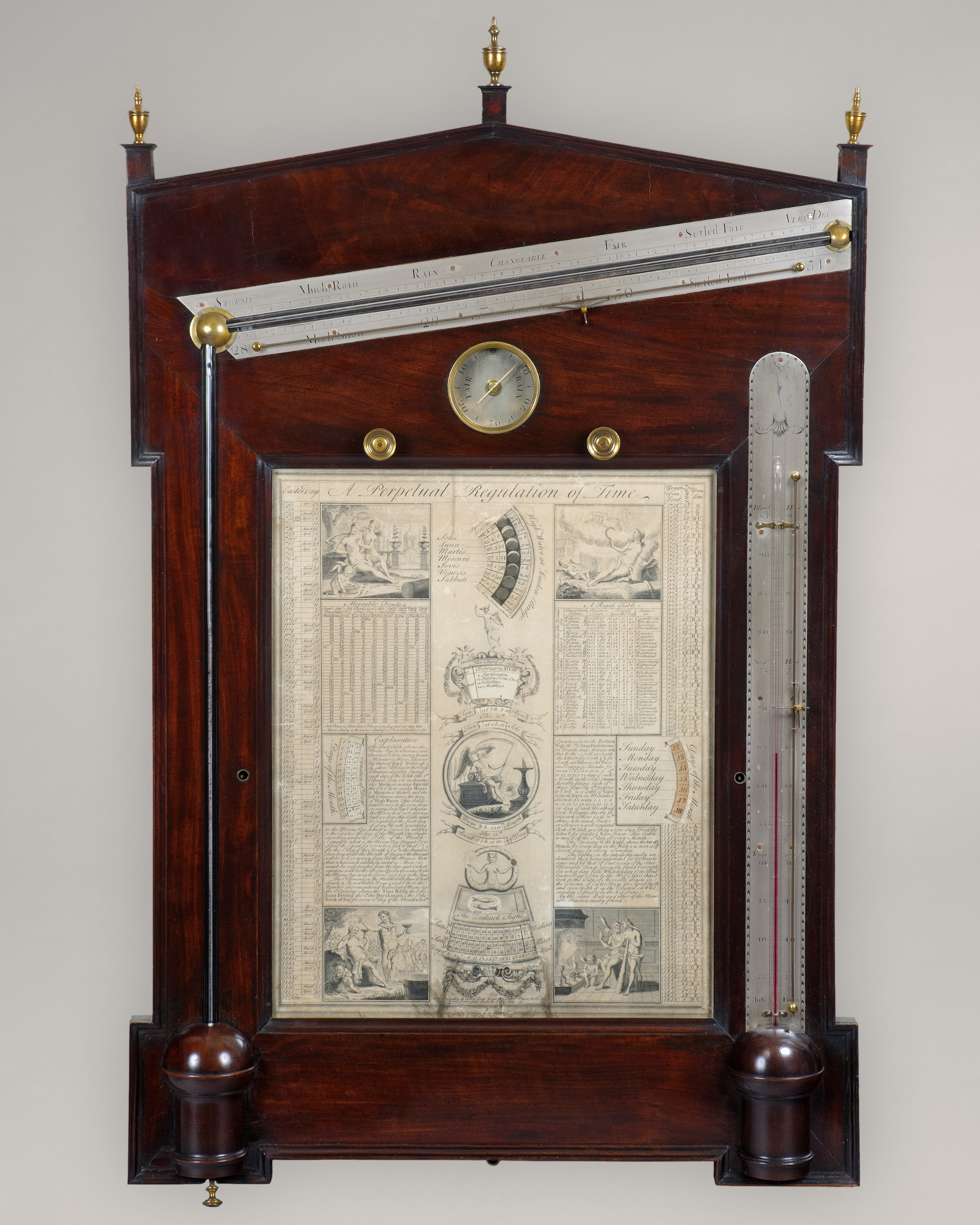
An important George III period angle barometer with perpetual regulation of time, by the pre-eminent maker whose name was synonymous with this type of complex barometer.
FRANCIS WATKINS, CHARING CROSS, LONDON, CIRCA 1760.
The well-preserved paper scales, entitled A Perpetual Regulation of Time, giving cylindrical, lunar, tidal and zodiacal information. The silvered angle scale to the barometer is signed F. Watkins, London and beneath the angled scale is a hygrometer.
Height: 105 cm
Francis Watkins is recorded as working at Sir Isaac Newton’s Head, 415 Charing Cross. He was apprenticed in 1737 to Nathanial Adams and became Free of the Spectacles Company in 1747 and a year later established his business in Charing Cross. Sir Nicholas Goodison, in his book ‘English Barometers’, states that the company “remained pre-eminent under several variations of the name until 1856 (Watkins and Smith, J. and W. Watkins, Watkins and Hill)”.
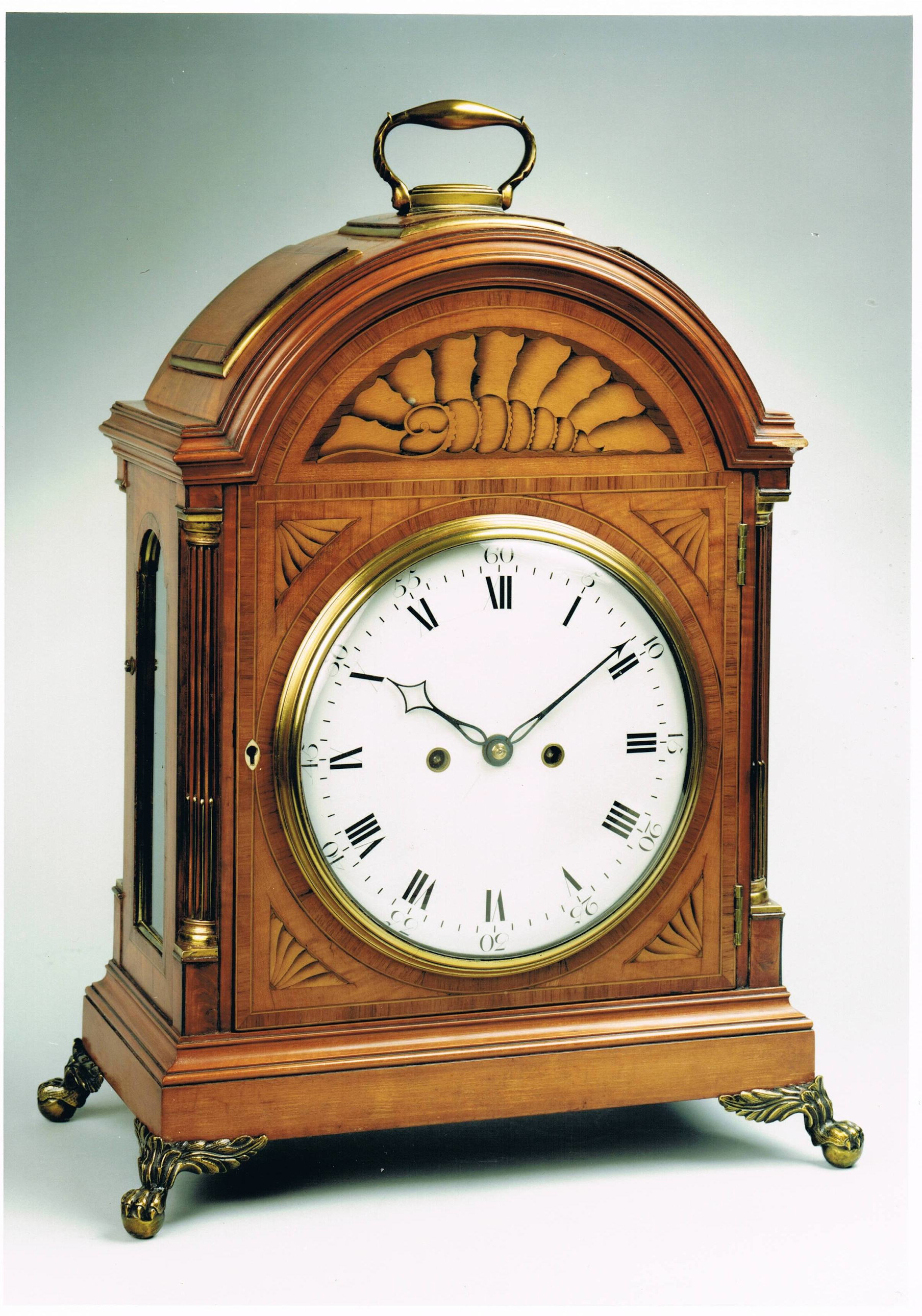
A fine and rare late 18th century George III period satinwood bracket clock of unusually large proportions, by Thomas Wright, Poultry, London, who was ‘Watch-maker to the King’
THOMAS WRIGHT, POULTRY, LONDON, circa 1785, WATCHMAKER TO THE KING
It is a superb example of the changing styles in clock cases around the late 18th century brought about by the increasing availability of exotic woods. The West Indian satinwood used by Wright is golden in colour and has the lustrous resemblance of a silky fabric. The decorative conch shell and fan motifs decorating the face of the case reflect the Georgians’ growth increasing interest in curiosity cabinets and collecting shells, coral and fossils.
Thomas Wright, 6 Poultry, London was admitted to the Clockmakers Company in 1770 as ‘Maker to the King’ signed on a bracket clock. He was a Quaker and a leading watchmaker. In 1783 he patented (N°: 1354) a form of detent escapement and compensation balance on watches.
Height: 46 cm
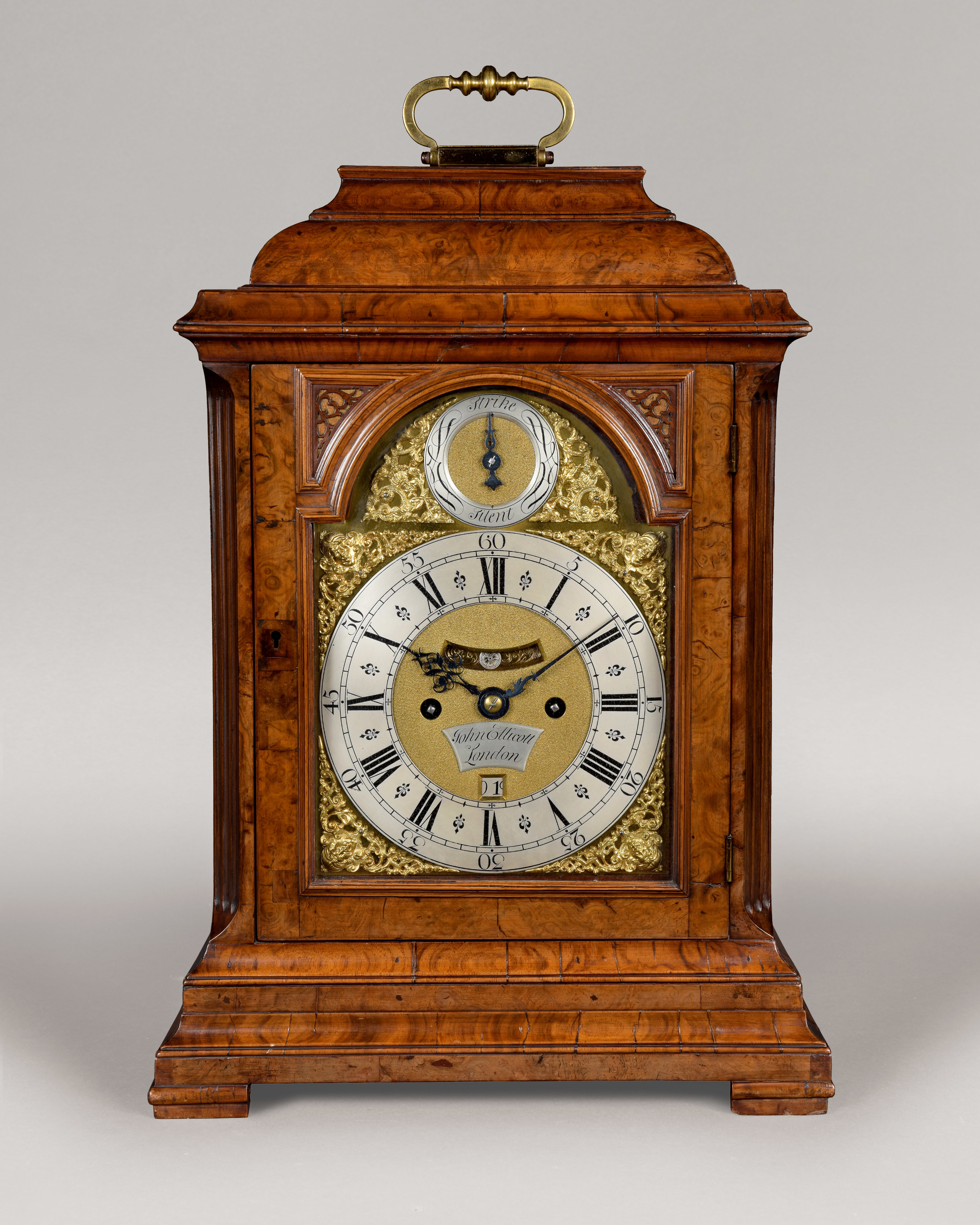
A fine, late George II period walnut table clock by this celebrated Royal maker.
JOHN ELLICOTT, LONDON
The exceptional inverted belltop case with its knopped brass carrying handle has finely figured walnut veneers which are repeated in its cross grain mouldings. It stands on a double plinth base with moulded block feet and the front corners of the case are fluted and canted with stop chamfers.
The fully restored verge movement is of 8-day duration and strikes the hours on a single bell. The brass dial has a finely matted centre with a dummy pendulum aperture, foliate corner spandrels, inset datework and a subsidiary dial in the arch for strike/silent. The blued steel pointers appear to be original. The maker’s signature John Ellicott London is on a raised silvered brass disc.
The substantial movement largely fills the case and the backplate is exquisitely engraved with foliage and a wheatear border which is repeated on the fixing brackets. The maker’s signature John Ellicott, London is set within the centre of the backplate.
Date: circa 1750
Height: 18 ¼ in (46 cm)
Width: 13 ⅛ in (33.25 cm)
Depth: 8 ⅝ in (21.75 cm)
* John Ellicott was born in 1706 and established his business in Swithin's Alley, Royal Exchange in 1728. He was the inventor of a compensation pendulum and he developed the use of the cylinder escapement. Like his peer George Graham, he became a member of the Royal Society, for which he wrote several papers. He was appointed Clockmaker to the King and he designed the London Hospital clock. He died suddenly in 1772 and was succeeded by his son. His work can be found in museums and royal collections throughout the world. Walnut table clocks of this quality and date are rarely found in such pristine condition.
Literature: R. Barder, The Georgian Bracket Clock 1714 – 1830, pp.55-56
Cescinsky and Webster, English Domestic Clocks, pp.295-296, fig. 315
B. Loomes, Clockmakers of the World: 21st Century Edition, p.244
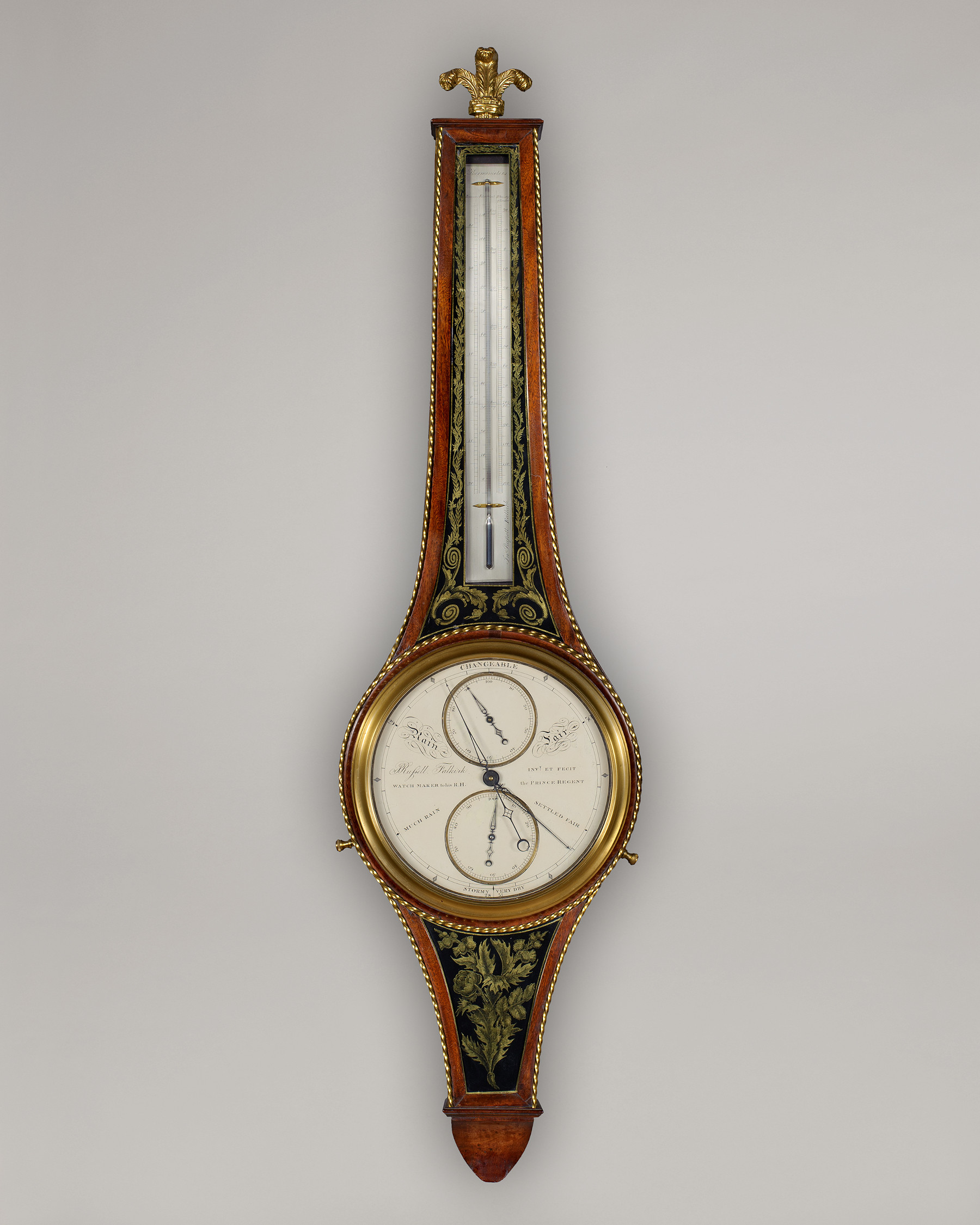
A rare and distinguished example of Russell’s ‘Royal’ barometers.
JOHN RUSSELL
Falkirk Invetor et Fecit
Watchmaker to his RH The Prince Regent
In the late eighteenth-century John Russell was recognised as an ingenious clock and watch maker and as such was given the Royal Warrant. He was further acknowledged as a superlative maker of wheel barometers, developing his own design and applying many of his detailed watch making skills to the mechanisms. His most celebrated work was his production of several special wheel barometers which came to be known as his ‘Royal’ barometers. Principally because he made two similar examples for George III and another for the Prince of Wales, who later became George IV. One example still hangs in the Royal Collection at Buckingham Palace and a further example hangs in the Victoria and Albert Museum.
These wonderful barometers are veneered in mahogany with verre églomisé panels to the upper section above the main dial and around the thermometer and to the lower section beneath the dial. The verre églomisé is decorated in gold on a black background and as always the case, the lower section is decorated with a thistle, the national symbol of Scotland. The brass finial to the pediment is in the form of the Prince of Wales feathers and is most probably indicative of his connection to the Royal family.
The dial is painted white with subsidiary dials. The upper subsidiary dial permits readings to 0.001 inch and the low subsidiary dial allows manual adjustment. All pointers are made of pierced steel.
The dating of the ‘Royal’ barometers is greatly aided by the fact that the title ‘Watchmaker to The Prince of Wales’ (later George IV) changed in 1811 on the establishment of the Regency to ‘Watchmaker to His Royal Highness the Prince Regent’. Consequently, this particular example may be dated between 1811 and 1817, when he died.
Date: circa 1811 - 1817
Height: 47¼ in (120 cm)
Width: 13 in (33 cm)
Depth: 3⅜ in (8.5 cm)
Bibliography: English Barometers 1680 – 1860, Nicolas Goodison. Page 228 – 236 with illustrations.
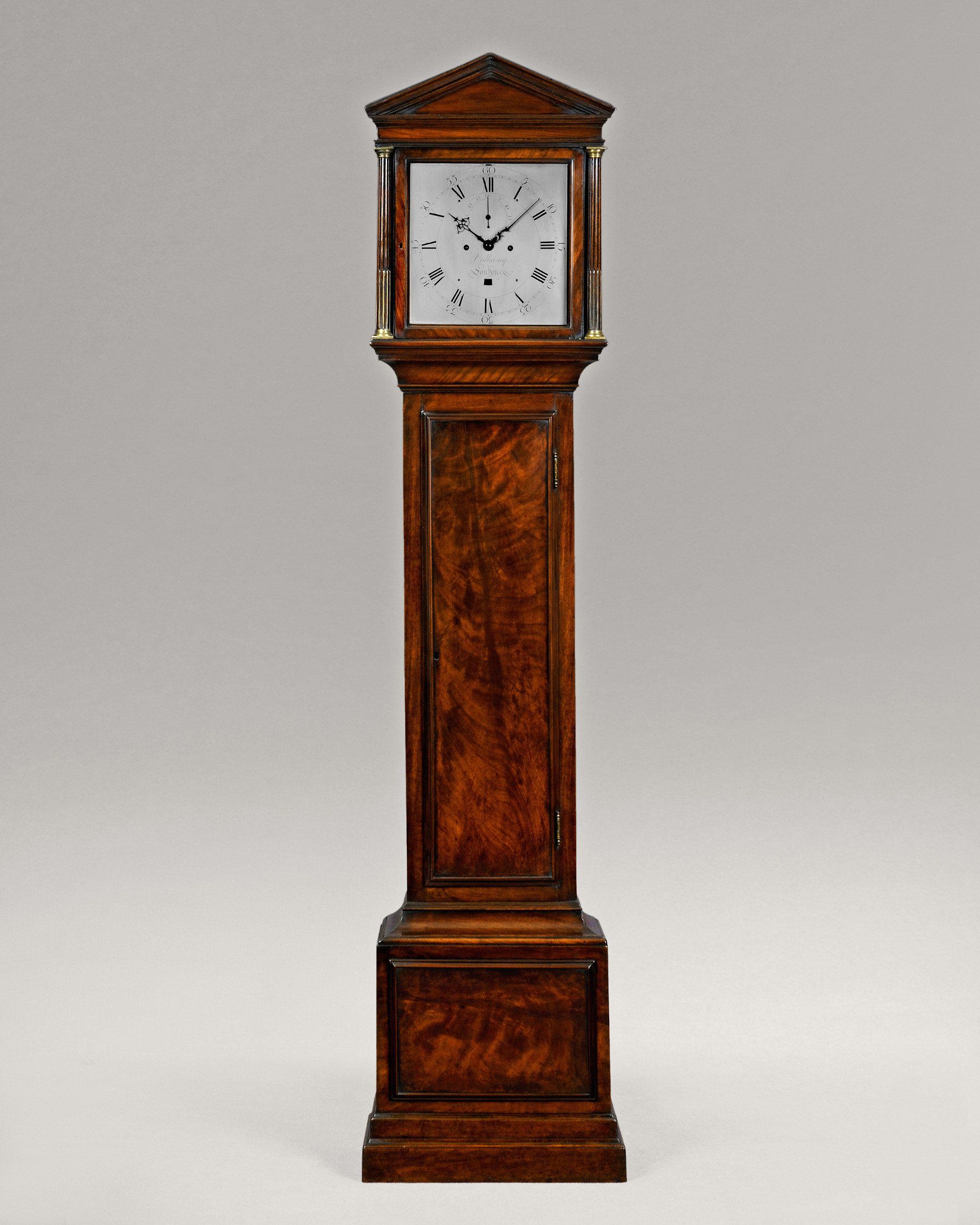
A fine George III longcase clock in an elegant architectural figured mahogany veneered case which has achieved a good mellow colour with excellent patination.
BENJAMIN VULLIAMY, LONDON
There is a double plinth to the panelled base, long moulded trunk door and the hood is flanked by free-standing grooved pillars with
brass reeds and brass capitals and bases.
The twelve inch silvered square brass dial is finely engraved and includes an aperture to view the day of the month and a strike/silent option. The centre of the dial is signed by the maker, Vulliamy London.
The high quality 8-day duration movement has five pillars, an anchor escapement and rack striking mechanism with the hours sounded on a bell. The ebonised wood rod pendulum has a large brass bob with a silvered calibrating rating nut beneath.
Date: circa 1780
Height: 85 in (216 cm)
* Benjamin Vulliamy was the second of the Vulliamy family who succeeded his father Justin. He was clockmaker to George III from 1772 and was responsible for a number of important precision clocks made for royalty and the aristocracy. Examples of his work can be found in museums and public collections throughout the world. He was the father of Benjamin Lewis Vulliamy and he died in 1811.
Reference: B. Loomes, Clockmakers of the World: 21st Century Edition, p.802
